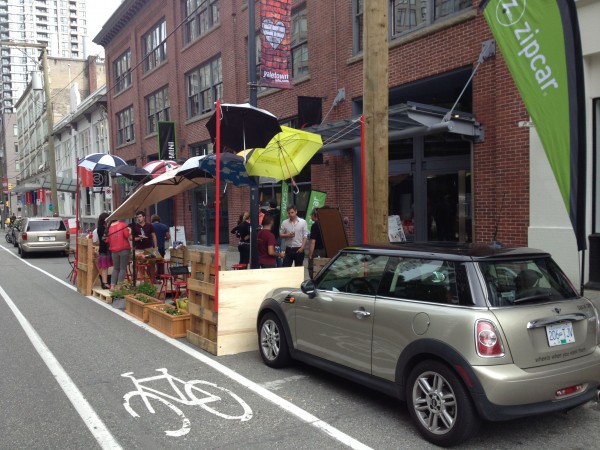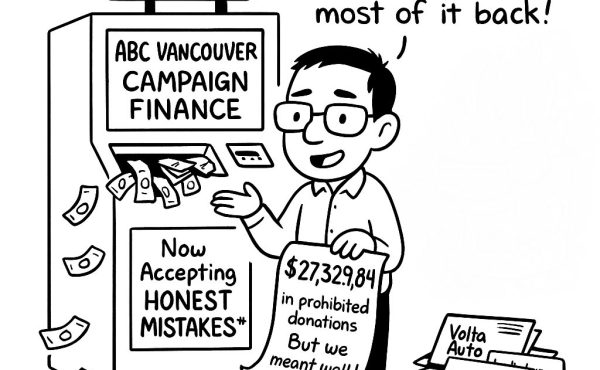
Public Intervention on Public Space
Last Friday (September 20) a special thing happened in parking stalls on streets in many city’s across North America, people took them over, took them back from cars, and made a statement that public streets are public places for all to enjoy. PARK(ing) Day intends to call attention to the need for more urban open space and to generate critical debate about the nature and role of streets in the public realm.
In Vancouver there were three successful installations where concepts about ways of sharing streets were conceived and built on parallel parking stalls to temporarily reprogram them for active use. The temporary public spaces at 500 Robson St downtown, 1050 Homer St in Yaletown, and 198 East 21st Ave in Mount Pleasant all created a more active streetscape to their neighbourhoods, even if it was just for one day. Designers and actors from a number of organizations came together to build these installations to illustrate ideals and movement towards a more inclusive and active system and ways of seeing streets as public places.
The Shifting Understanding of Public Spaces
Prior to the twentieth century, streets, parks, squares, and other public gathering places were symbols of collective well-being and possibility. These places were inextricably linked to the organic genius and flows of social interaction that drives cultural development of urban communities both large and small.
An important feature of public spaces is the democratic manifestation that there is no ownership of a “public” space, yet history reveals that both public- and private-sector agents often in reality share or transfer ownership of this public good through many means and measures, such as set-backs, community amenity contributions, and privately-owned or controlled spaces that the public occupy both de-facto and de-jure.
Pop-up parks are a product of a growing interventionist movement that takes advantage of vacant or underutilized spaces within the street rights-of-way through innovative and often spontaneous community-based designs. Progressive municipalities have a recent history of temporarily closing streets to vehicular traffic for pedestrian activity and social interaction, prior to adopting these pop-up parks projects.
It is the streets that have the greatest potential to serve a multitude of social, recreational, and ecological needs when designing the city for people. They are not only the places we occupy in the daily flow of the city, but are a significant proportion of urban space.
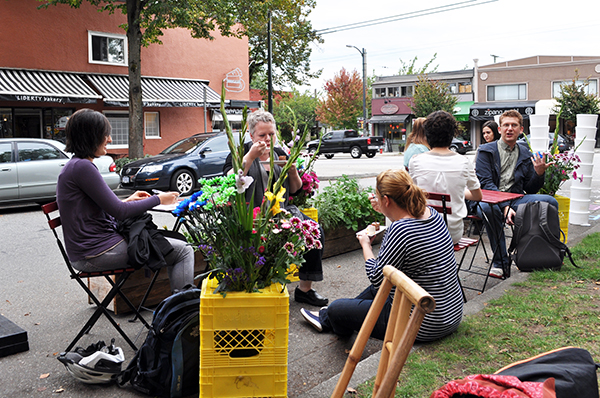
Pavement to Parks
By the turn of the millennium, increasing global dependence on automobiles and diminishing public spaces prompted a collaborative artists and designers group, Rebar, to take direct action through a unique and playful tree-bench-sod installation on November 16, 2005. Internationally recognized as PARK(ing) Day, the annual open-source global event brings together community members, comprised largely of artists and activists, who collectively convert parking spaces into temporary public parks lasting typically from 2 to 6 hours (the length of time often dependent on whether spaces are metered or not).
Inspired by the recent success of creative placemaking in New York, the San Francisco Planning Department launched an initiative in 2009 to reclaim portions of San Francisco’s streets and public rights-of-way. ‘Pavement to Parks’ is a joint effort between the Mayor’s Office, San Francisco Planning Department, the Department of Public Works, and the Municipal Transportation Agency.
Pavement to Parks is a program originating in San Francisco that is a creative response to inhospitably wide streets. The program seeks to temporarily reclaim these spaces and inexpensively transform them into public amenities. Rebar and rg-architecture worked on the first several Pavement to Parks projects and continue to be heavily involved. SF Planning merely facilitates the programming of Pavement to Parks projects – active roles are assumed by site-specific partners, who design, fabricate, and install. Pavement to Parks projects build off of the community partnership model, where much of the labor is volunteered by members of the community and pro-bono services are commonly provided by art and design firms.
![The decking, vegetation, and wooden bench of Urban Pasture parklet adds a semi permanent extension of pedestrian space on Robson to socialize and eat. [Photo: John Paul Catungal]](http://spacing.ca/vancouver/wp-content/uploads/sites/6/384644_10151121436721154_1402340190_n.jpg)
In the Lower Mainland, parklet installations have been popping up in many neighbourhoods.
- Parallel Park, at 14th and Main in Mount Pleasant, creates a protected pod of dense seating next to the JJ Bean,
- Urban Pasture, at the 1000 Block of Robson Street in the West End, has wood decking and planting as a mini urban oasis in the heart of the city,
- The Hot Tubs on 44th and Fraser in Sunset, create a bit of heat with social seating,
- Park-A-Park, for most of the summer at 1st and Commercial in Grandview Woodlands, has been moving locations as it is a protected and movable seating installation created by the repurposing a demolition skip,
- Take-Out, under the Surrey City Centre SkyTrain Station, is the product of the PARKit design challenge and features unique furniture designs and a pop-art feel.
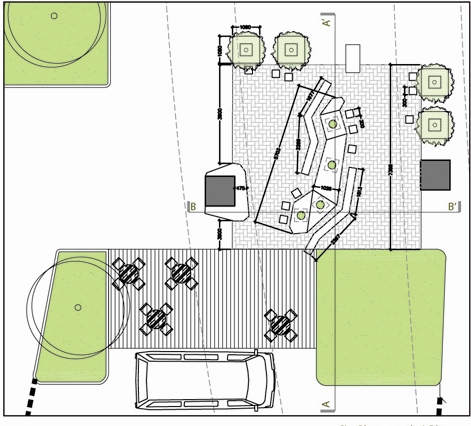
VIVA Vancouver launched the 2013 Parklet Pilot Program Guide and initial application process in June, prompting business and shop owners in Kitsilano, Grandview-Woodland, Riley Park, Kerrisdale, and Downtown to consider applying. Among other applicants, Chocolaterie de la Nouvelle France has been selected by VIVA Vancouver to install a parklet. Spanning 2 parking spaces, the parklet is currently being designed by PWL Partnership with anticipation to be installed by Tradeworks this fall.
PARK(ing) Day @ 21st Ave and Main St

Many passersby stopped to glance at what was unfolding in the two parking spaces at 21st Ave and Main St. Hosted by Chocolaterie de la Nouvelle France, red patio furniture neatly lined up against the store facade was brought into the road. It was juxtaposed with bright yellow milk carts filled with bundles of fresh cut flowers, delicately slipped through the grid surface openings. A life-size “Hi” composed of empty gelato containers faced Main St, welcoming everyone on foot and bike.
Enhancing the friendly character of the space, children and adults had fun with an organic bubble maker donated from The Soap Dispensary, located a block down Main St. Planter boxes from Coco et Olive bordered the traffic facing side of the Park(ing) Day installation, providing a comfortable buffer from moving vehicles.
“Everybody came together that morning. A neighbour showed up with a leaf blower to clean the area, another one lent us games. Some businesses also gave a hand. It was a community effort, really,” says Anne-Genevieve Poitras, owner of Chocolaterie de la Nouvelle France.
The shop’s first PARK(ing) Day installation took on an aesthetic form matching the mural of a Provence house painted on the building by a local artist and resident in the neighbourhood, years ago. Locals were excited over the temporary public space, providing only supportive comments, while visitors from across Vancouver or out of city, seemed to hesitate before sitting down. This installation matched the fronting business enough to prompt a few people to ask if it was okay to join in – despite signage declaring it as PARK(ing) Day and a “public space.” Nevertheless many familiar faces from the neighbourhood came by to experience PARK(ing) Day and chat with fellow Vancouverites.
PARK(ing) Day @ 500 Robson St
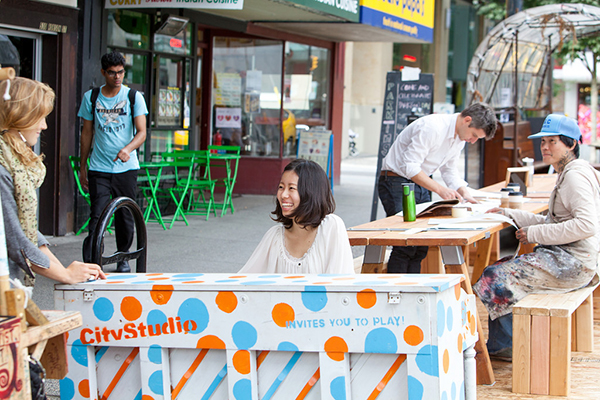
Image: Eric Scott Photography
Taking one week to prepare, VPSN selected a location for PARK(ing) Day on Robson St where high foot traffic occurs along a congested sidewalk block.
A fleet of mobile public spaces occupied three metered parking spaces with fronting businesses: Falafel Maison, Viet Sub, and Curry Fusion. Owners were notified of PARK(ing) Day in advance and were enthused, hoping the space to be more permanent. VPSN collaborated with City Studio, Tradeworks, Ken Lum’s Little Shop of Happenstance, and Modo Car Share to create an outdoor living room featuring wooden components such as the poka dot piano, an art cart, harvest tables and benches, as well as a wagon with pews containing overhead structure.
JAPADOG staff at the restaurant and food stands were on holiday for the week, but owner Noriki Tamura was still very pleased to hear of the temporary public space installation. VPSN recently released a visually engaging video acknowledging volunteers and visitors who assembled and hung out at the “smorgasbord of urban interventions” through the course of the day.
PARK(ing) Day @ 1050 Homer St
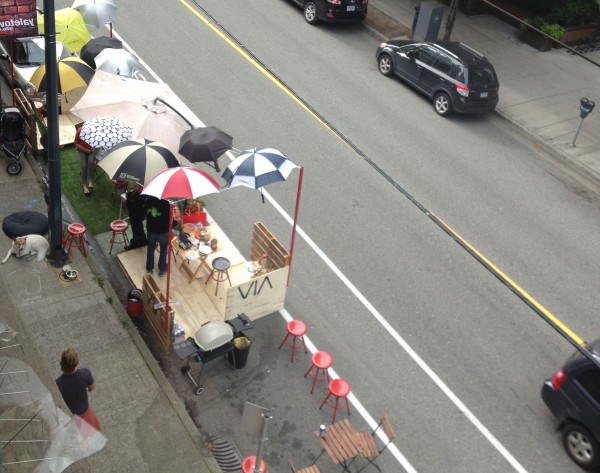
VIA Architecture, created a full 2-Stall installation in front of their building to raise awareness over this debate around quality urban spaces. VIA’s team volunteered time to design and set up two parklets in front of both their Vancouver and Seattle offices, with a concept of “Playing in the Street.” Built with recyclable and reused materials, VIA’s structured parklet assembled shipping pallets to create curb-level flooring and to define the edges of the park. Movable furniture was used to allow flexibility in the space and plant pots from employee’s gardens were included to provide a little touch of nature.
When the forecast threatened rain, the team altered the design to include an overhead canopy of umbrellas. Inspiration came from over-street canopies in Barcelona but was definitely fitting to the local climate. Instead of hiding from the rain, an opportunity was taken to celebrate it, if only visually.
Overall the VIA parklet drew the attention that was sought. Throughout the day it received positive feedback from curious passers-by and has spurred energy towards looking at more permanent options. Of the best moments was a Parking ByLaw Enforcement Officer walking by smiling and with his hands in the air saying “Even if I wanted to do it, what would I ticket!”
A Stall to Arms
Next year it is hoped that the event’s partner organizations, like the Vancouver Public Space Network make inroads with the City to make the event sanctioned and formally promoted. Making Vancouver’s PARKing day competitive with other cities should be a goal – Seattle had about 45 installations to our three. Inclusive and friendly competition will be key to making this bigger and better next year, as it is events like these that help us look beyond our street front and strive toward better options to build a comprehensive system of public open spaces, especially in our streets.
So next year rise to the challenge:
Go Play In the Street!
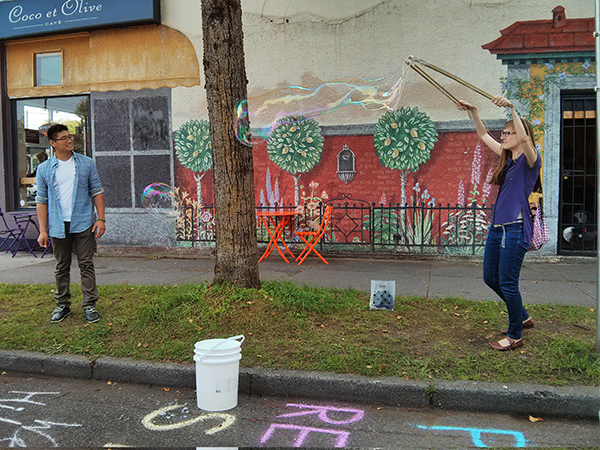
***
Kathleen Corey likes tiny apartments over shops, hikes with panoramic city views, and flowing urban landscapes. Working toward her Master of Landscape Architecture at the University of Guelph, her thesis is on tactical urbanism strategies and programming for parklets with a comparative study in Vancouver and San Francisco. She is an intern at PWL Partnership.
Brendan Hurley is a local urban designer who focuses on planning for adaptive neighbourhood change. His recent work has been internationally focused, but is strongly rooted in his native Vancouver. Living and working out of the heart of downtown, he remains keenly focused on the region’s development and history. He is a Planner with VIA Architecture.

